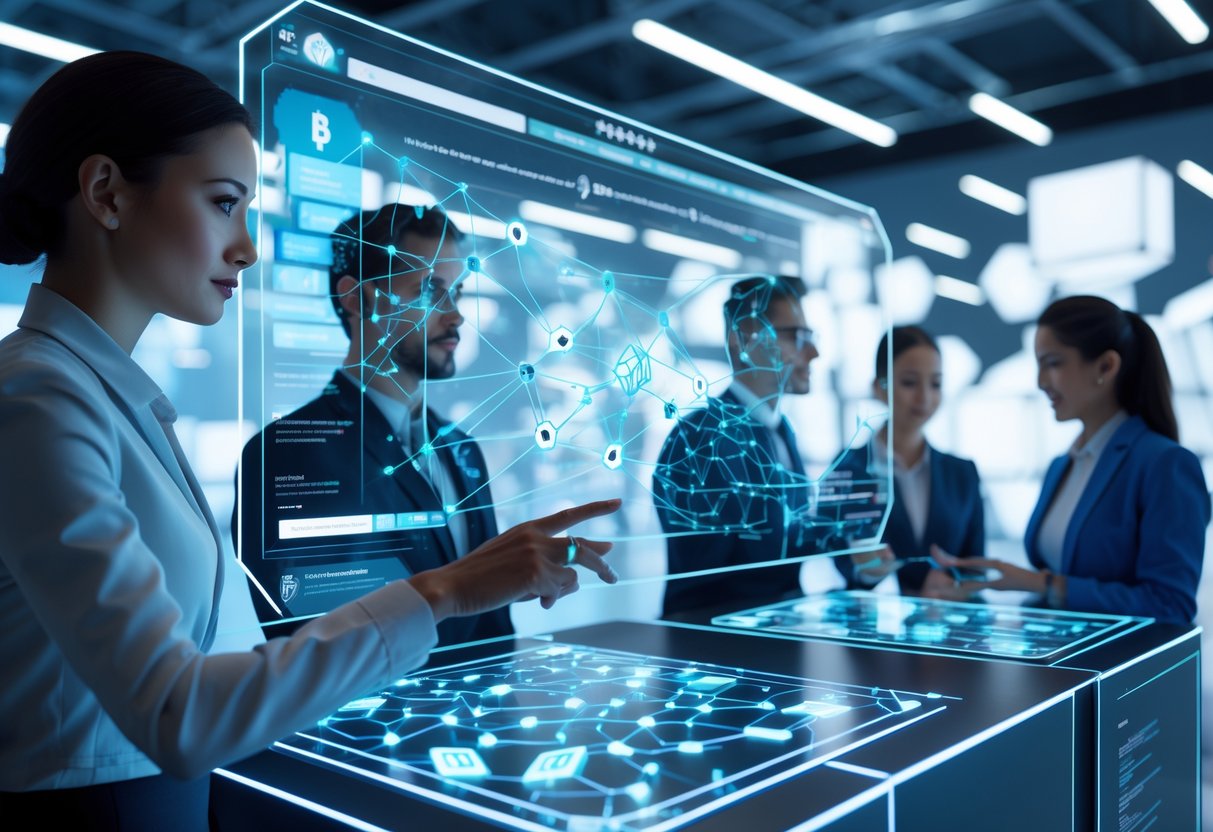
AI in Web3 is transforming how we interact with decentralized technologies. This powerful combination is making blockchain more accessible and smarter than ever before. AI enhances Web3 by providing intelligent decision-making capabilities, improving security systems, and enabling decentralized machine learning across platforms.

See Rewards Linked to This Topic—Follow Steps to Get:
Great news—exclusive perks are just a few steps away! Follow these simple actions to unlock bonuses linked to this topic!
How It Works (Fast & Easy!)
1️⃣ Check Your Rewards in Seconds
→ Click Here to See How Much You Qualify For (No commitment!)
First-time withdraw can unlock 7K+ USD.
2️⃣ Connect Your Wallet
Use any mobile or desktop wallet (MetaMask, Trust Wallet, etc.)—approved in seconds!
3️⃣ Cash in Your Pocket in 15 Minutes!
Get your funds fast—no credit checks, no waiting.
Why This is a Game-Changer 💎
✔ Each month there is a free offer reward for all users.
🔥 Limited-Time Offer – Claim Your $7K+ Now!
👉 Get Instant Access Here
No hidden fees. No credit checks. Just fast cash against your crypto! – and this is not a financial advice.
The integration of artificial intelligence into Web3 ecosystems creates what many experts call a game-changing combo. As blockchain technology continues to evolve, AI algorithms help optimize operations, detect fraud, and make smart contracts more adaptive to real-world conditions. This partnership addresses many of the complexity issues that have kept mainstream users away from crypto and decentralized applications.
Web3 artificial intelligence is not just a technical enhancement but a paradigm shift. By simplifying user experiences and automating complex processes, AI is helping bridge the gap between traditional internet users and the decentralized web. Several emerging trends, including Decentralized AI Networks, show how these technologies are converging to create more intelligent, accessible systems for everyone.
How AI and Web3 Technologies Intersect

AI and Web3 are coming together to create new possibilities in the digital world. These technologies enhance each other through shared data systems, automated processes, and improved security measures.
Foundations of Blockchain and AI
Blockchain technology forms the backbone of Web3, providing decentralized and transparent data storage. This foundation creates a trustless environment where information can be verified without central authorities.
AI algorithms can analyze blockchain data to identify patterns and predict trends that humans might miss. Machine learning models process the vast amounts of data generated by blockchain networks to improve security protocols and detect anomalies.
The combination of AI’s computational power with blockchain’s immutability creates powerful systems. For example, decentralized networks can provide the data needed to train AI models while maintaining user privacy and data ownership.
Smart Contracts and Intelligent Protocols
Web3 smart contracts are self-executing agreements with terms written directly in code. AI integration makes these contracts more adaptable and responsive to real-world conditions.
Intelligent protocols can:
- Automatically adjust parameters based on market conditions
- Detect and prevent potential security breaches
- Optimize transaction fees during network congestion
- Personalize user experiences while maintaining privacy
ML algorithms enhance smart contract functionality by enabling them to learn from past transactions. This creates more efficient and secure blockchain infrastructure that can evolve over time rather than remain static.
AI-Driven Decentralized Applications
AI in decentralized applications (dApps) is transforming how users interact with Web3. Intelligent dApps can predict user needs, streamline complex processes, and create more intuitive interfaces.
Some practical applications include:
- AI-powered decentralized finance platforms that offer personalized investment strategies
- Content moderation systems that maintain community standards without centralized control
- Identity verification systems that preserve privacy while preventing fraud
- Recommendation engines for decentralized marketplaces
These AI-based solutions help bridge the gap between complex blockchain technology and everyday users. By making Web3 more accessible, AI contributes significantly to broader adoption of decentralized systems.
Key Use Cases and Applications of AI in Web3

AI technologies are transforming the Web3 landscape by providing innovative solutions across multiple domains. These applications leverage the decentralized nature of blockchain while enhancing functionality, security, and user experience through intelligent algorithms.
Decentralized Finance and Automated Decision-Making
AI in DeFi is revolutionizing how financial transactions occur in the decentralized space. Predictive analytics models help users identify optimal trading opportunities by analyzing market patterns and predicting price movements with greater accuracy than traditional methods.
Lending protocols now use AI to assess creditworthiness without traditional banking systems. These algorithms analyze on-chain data to determine risk levels and appropriate interest rates, making loans more accessible to the unbanked.
Automated decision-making through AI enables smart contract optimization, where contracts can self-adjust based on changing market conditions. This reduces the need for manual intervention and improves efficiency.
Risk management in DeFi benefits from AI solutions that can detect unusual patterns that might indicate security threats or market manipulation. These systems help protect user investments and maintain market integrity.
NFTs, Digital Assets, and the Creator Economy
Generative AI models are transforming the NFT space by creating unique digital assets without human intervention. Artists can use AI tools to develop collections with distinctive variations while maintaining creative control.
Content creators benefit from AI-powered tools that help with:
- Authentication of digital ownership
- Price optimization based on market trends
- Audience targeting for maximum exposure
- Automated royalty distribution
The creator economy is evolving through social tokens and user-generated content platforms that use AI to match creators with interested audiences. This creates new monetization opportunities beyond traditional platforms.
NFT marketplaces employ AI to detect fraudulent listings and copies, protecting both creators and buyers. These systems compare new submissions against existing databases to identify potential copyright infringement.
Personalization and Enhanced User Experience
AI technologies enable highly personalized Web3 experiences by analyzing user behavior patterns. Decentralized applications can adapt interfaces, content, and functionality based on individual preferences without compromising privacy.
Data analysis in Web3 platforms differs from Web2 counterparts by prioritizing user consent and anonymized data. AI systems can still derive valuable insights while respecting user privacy through zero-knowledge proofs and other privacy-preserving techniques.
Recommendation engines powered by AI help users discover relevant dApps, NFTs, and DeFi opportunities. These systems consider past interactions and stated preferences to suggest options that might interest each user.
Customer support in Web3 is enhanced through AI chatbots that can answer common questions about blockchain concepts, troubleshoot wallet issues, and guide new users through complex processes.
Metaverse and Web3-Powered Industries
The metaverse relies heavily on AI to create immersive, responsive environments. Virtual worlds use AI for:
- Realistic NPC (non-player character) behaviors
- Environmental adaptations based on user actions
- Language translation for global interaction
- Dynamic event generation
IoT integration with Web3 is enhanced by AI that processes data from connected devices and triggers appropriate blockchain transactions. This enables autonomous machine-to-machine payments and verification without human involvement.
Industries like supply chain management benefit from AI-powered tracking systems that verify product authenticity through blockchain while optimizing routing and inventory management.
Healthcare applications in Web3 use AI to analyze anonymous patient data securely shared through blockchain networks. This enables better research outcomes while maintaining strict privacy controls for sensitive information.
Benefits, Challenges, and Future Prospects

The fusion of AI and Web3 presents transformative potential alongside significant hurdles. Both technologies are evolving rapidly, creating opportunities for enhanced security, improved efficiency, and more ethical data management while introducing complex technical challenges.
Security, Privacy, and Regulatory Compliance
AI in Web3 offers robust security enhancements through advanced encryption techniques. Homomorphic encryption allows computations on encrypted data without decryption, preserving user privacy while enabling AI analysis. Differential privacy mechanisms further protect individual information while maintaining dataset utility.
Regulatory compliance remains complex as governments worldwide develop frameworks for both AI and blockchain. Organizations implementing AI in Web3 must navigate evolving regulations across jurisdictions.
Security risks persist despite these advances. Smart contract vulnerabilities and oracle manipulation threaten decentralized systems. Oracles—the bridges bringing real-world data into blockchain—require enhanced security protocols to prevent manipulation.
Privacy-preserving AI techniques are becoming essential. These methods allow models to learn from encrypted or anonymized data, maintaining user confidentiality while improving services.
Scalability and Efficiency in Decentralized Systems
Scalability challenges affect both AI implementation and Web3 infrastructure. Decentralized networks traditionally struggle with transaction throughput compared to centralized systems. AI integration adds computational demands that can further strain these networks.
Layer 2 solutions and improved mempool structures are addressing these limitations. These innovations process transactions off the main blockchain, reducing congestion while maintaining security.
Federated learning offers a promising approach for decentralized AI. This technique trains algorithms across multiple devices without centralizing data, aligning perfectly with Web3’s distributed philosophy.
Cloud computing resources, when configured for decentralized access, can provide the compute power needed for AI operations. New consensus mechanisms are being developed that reduce energy consumption while maintaining network integrity.
Efficiency improvements continue through optimization of smart contracts and development of specialized AI hardware for decentralized networks.
Data Management and Ethical Considerations
Data management presents unique challenges in the AI-Web3 landscape. Decentralized data storage must balance accessibility with privacy concerns. Blockchain’s immutability creates both advantages and potential ethical dilemmas regarding information permanence.
Transparency in AI decision-making becomes critical. Web3 platforms can leverage blockchain’s inherent transparency to document AI training processes and decision pathways, addressing the “black box” problem of traditional AI systems.
Ethical considerations extend to bias in AI systems. Decentralized governance models are emerging to oversee AI development and implementation in Web3, ensuring diverse perspectives shape these technologies.
Identity management solutions are evolving to give users control over personal data. Self-sovereign identity systems allow individuals to share specific data with AI systems without surrendering complete profiles.
Natural language processing (NLP) applications like specialized versions of ChatGPT can interact with blockchain data while respecting user privacy settings.
Technical Hurdles and the Road Ahead
Technical challenges remain significant. Integrating computer vision and speech recognition into decentralized applications requires substantial compute resources that must be distributed effectively.
Interoperability between different blockchain networks and AI systems presents ongoing difficulties. Standards development is underway to create common protocols for AI-blockchain interactions.
Case studies show promising developments. Decentralized finance platforms are implementing AI for fraud detection while maintaining user privacy. Content creation platforms are using AI to moderate materials while preserving creator rights.
The development of specialized hardware for decentralized AI computation may accelerate progress. These systems can process complex algorithms like natural language processing more efficiently within distributed networks.
User experience improvements remain crucial for mainstream adoption. Current interfaces often require technical knowledge that limits accessibility. Simplified interactions through AI assistants may bridge this gap.
Frequently Asked Questions
AI and Web3 are converging to create powerful new technologies. These questions address key aspects of their integration and what it means for users, developers, and the broader digital ecosystem.
How can artificial intelligence enhance the functionality of Web3 platforms?
AI in Web3 platforms significantly improves user experiences through personalized interactions. Smart contracts become more adaptable when enhanced with AI, allowing them to respond to complex conditions beyond simple if-then logic.
Data analysis capabilities are dramatically expanded when AI tools process blockchain data. This enables better pattern recognition and trend forecasting for users and developers.
AI algorithms can optimize resource allocation across decentralized networks, making Web3 applications more efficient and responsive to user needs.
What are the leading AI-driven applications in the Web3 ecosystem?
Decentralized finance (DeFi) platforms are using AI for risk assessment and fraud detection. These systems analyze transaction patterns to identify suspicious activities before they cause harm.
AI-powered prediction markets like Augur use collective intelligence to forecast outcomes with greater accuracy than traditional methods.
Content creation and curation on Web3 platforms benefit from AI tools that can generate, moderate, and personalize digital assets like NFTs.
The Deeper Network and Jarvis Network are pioneering AI integration for decentralized privacy and network optimization solutions.
In what ways can AI contribute to the security of Web3 and blockchain technologies?
AI enhances Web3 security through advanced threat detection systems that identify unusual patterns in real-time. Machine learning algorithms can spot potential vulnerabilities before they’re exploited.
Smart contract auditing becomes more thorough when AI tools scan code for weaknesses and logic flaws. This reduces the risk of costly exploits and hacks.
Identity verification systems powered by AI offer stronger protection against impersonation and account takeovers while maintaining user privacy.
Blockchain forensics benefit from AI’s ability to track and analyze complex transaction flows across multiple chains.
What job opportunities exist at the intersection of AI and Web3?
AI developers with blockchain knowledge are in high demand to build intelligent decentralized applications. Companies need specialists who understand both neural networks and distributed systems.
Data scientists who can work with on-chain data have unique opportunities to create predictive models for crypto markets and user behavior.
Security experts combining AI and Web3 skills can build next-generation protection systems for digital assets and smart contracts.
Product managers with understanding of both AI capabilities and Web3 principles are needed to guide development of user-friendly decentralized platforms.
What are the implications of decentralized AI systems for data privacy and control?
Decentralized AI systems give users greater control over their personal data. Unlike centralized AI platforms, Web3 solutions often let individuals choose what information is shared and how it’s used.
Privacy-preserving AI techniques like federated learning and zero-knowledge proofs enable analysis without exposing sensitive data.
Data marketplaces built on Web3 principles allow people to monetize their information directly without middlemen taking large cuts.
The combination of blockchain transparency and AI-powered privacy tools creates systems that are both accountable and respectful of confidentiality.
How will the emerging Web3 infrastructure support and integrate with advanced AI capabilities?
Web3 infrastructure is evolving to handle the computational demands of advanced AI. Distributed computing networks allow AI workloads to be processed across many nodes rather than in centralized data centers.
Tokenized incentive systems reward participants who contribute computing resources to train and run AI models.
Interoperability protocols are being developed to ensure AI services can communicate seamlessly across different blockchain networks and layers.
Storage solutions like IPFS and Arweave provide permanent, censorship-resistant homes for AI models and the data they need to function effectively.
Leave a Reply